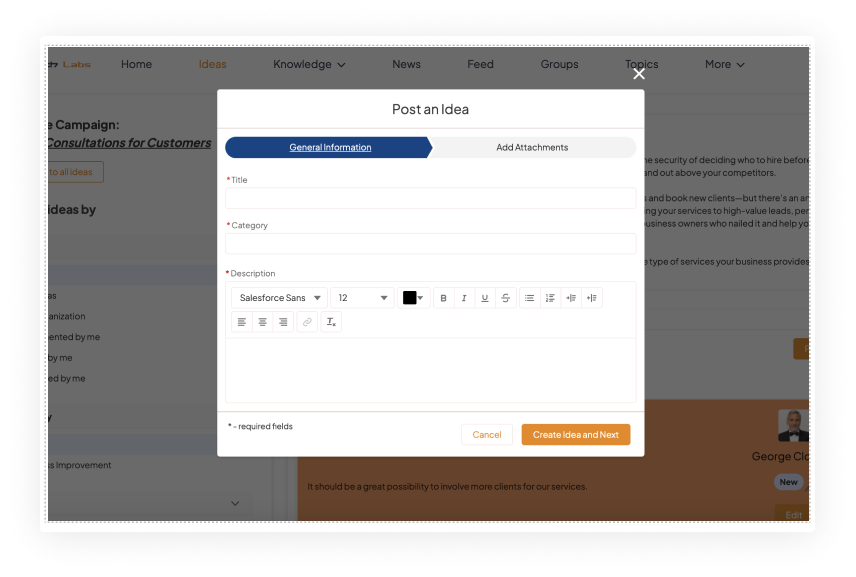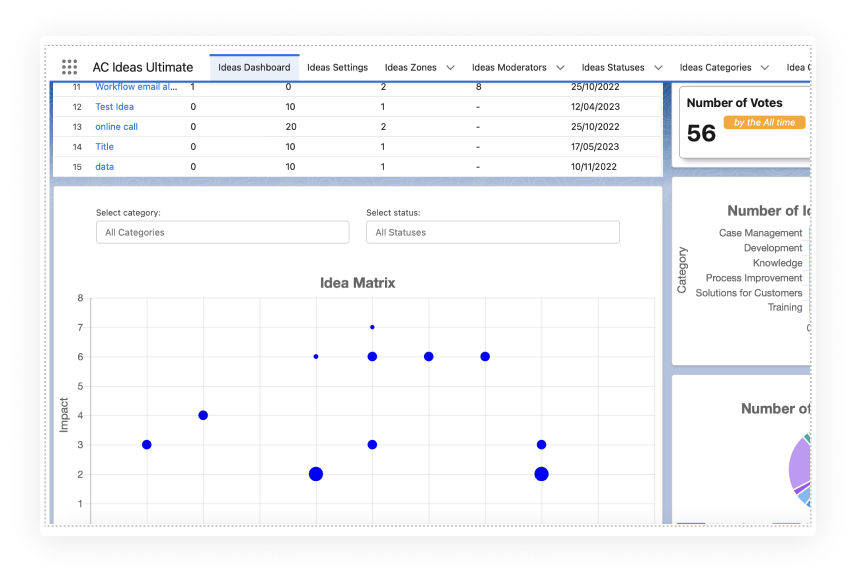Salesforce Idea Management: How to Come up with Ideas?
An outside perspective on your products is crucial, fresh ideas are invaluable, and developing your product while considering your clients’ requests is essential. For organizations leveraging Salesforce, idea generation is not just a creative exercise but a strategic imperative. Salesforce idea management offers a structured approach to gathering, evaluating, and implementing new ideas to drive business growth and enhance customer satisfaction. In this article, we’ll explore the significance of idea generation and delve into practical strategies for coming up with great ideas.
Understanding the Need for Ideas
Ideas form the foundation of growth within organizations. By constantly generating new ideas, businesses can identify opportunities for improvement, develop innovative solutions, and stay ahead of constantly changing market trends. Good ideas have the power to transform business processes, drive revenue growth, and enhance the overall customer experience. Salesforce idea management provides a structured framework for harnessing the collective creativity of employees, customers, and partners to fuel organizational success.
Here are a few key reasons why setting up the creative process and acknowledging a different perspective could be truly beneficial:
- Engaging employees in idea generation fosters a sense of ownership and empowerment, leading to higher levels of employee satisfaction and retention.
- Customer-centric idea generation enables organizations to address customer pain points and deliver solutions that meet their evolving needs and expectations.
- Partner collaboration in idea generation promotes synergy, driving mutually beneficial outcomes for all stakeholders involved.
Sources of Inspiration
New ideas can stem from a variety of sources within the Salesforce ecosystem. Employee feedback, customer insights, and partner collaboration are valuable sources of inspiration for generating good ideas. By fostering a culture of open communication and idea sharing, organizations can tap into the collective knowledge and creativity of their stakeholders to generate as many ideas as they can process. Whether through brainstorming sessions, customer surveys, or cross-functional collaboration, organizations can generate the best ideas that address critical business challenges and opportunities.
How to gather more ideas across various channels:
- Employee feedback mechanisms such as suggestion boxes, surveys, and open forums encourage active participation and idea sharing among employees at all levels of the organization.
- Customer feedback channels, including surveys, social media listening, and customer support interactions, provide valuable insights into customer needs, preferences, and pain points.
- Partner collaboration platforms facilitate idea exchange and co-creation, enabling organizations to leverage the expertise and resources of their partners to drive growth.
Utilizing Salesforce Tools for Idea Generation
Salesforce offers a range of tools and platforms designed to facilitate idea generation and collaboration. It provides dedicated spaces for employees, customers, and partners to submit, discuss, and vote on ideas. Features such as Chatter enable real-time collaboration and feedback, allowing stakeholders to contribute to idea generation from anywhere, at any time. Salesforce Analytics offers powerful data visualization and analysis capabilities, allowing organizations to identify trends, patterns, and insights that can inform the ideation process.

However, using this functionality as it is has some inconveniences. To manage and navigate ideas, you need to switch to the Salesforce Classic interface, which may frustrate many organizations accustomed to using Lightning Experience (LEX). But not to worry, as we are going to introduce you to the solution right away: LEX-native idea management software that even extends standard Salesforce functionality! Easily track your existing ideas and create a friendly space where users can generate new ideas with AC Ideas Ultimate – find out more about this app and Experience Cloud for idea management in this article:
What Is Idea Management in Salesforce: Understanding the Power of Innovation

Best Practices for Idea Generation
Generating new ideas requires a combination of creativity, collaboration, and strategic thinking. Best practices for streamlining ideas generation flow include hosting brainstorming sessions, implementing a rewards system for better ideas, and organizing ideation contests to engage stakeholders and unlock the potential of every creative person. Additionally, business leaders should encourage a culture of experimentation and risk-taking, where failure is viewed as a learning opportunity rather than a setback. By embracing a structured approach to idea generation and nurturing this creative industry, organizations stand to benefit significantly.
Here are 5 best practices to help you personally generate new ideas:
- Keep an idea journal: Carry a notebook or use a digital note-taking app to jot down ideas as they come to mind throughout the day. Reviewing these notes regularly can spark new connections and insights.
- Engage in diverse activities: Expose yourself to a variety of experiences, hobbies, and interests outside of your usual routine. Engaging in diverse activities can stimulate creativity and provide fresh perspectives that inspire new ideas.
- Collaborate with others: Collaborate with colleagues, peers, or mentors who have different expertise or viewpoints. Engaging in discussions, brainstorming sessions, or collaborative projects can generate ideas through collective creativity.
- Practice mindfulness and reflection: Set aside time for quiet reflection and mindfulness practices to clear your mind and tap into your creative potential. Activities such as journaling, or taking walks in nature can help stimulate creativity and generate a great idea or even a bunch of them.
- Embrace constraints: Instead of viewing constraints as limitations, embrace them as opportunities for creative problem-solving. Constraints can inspire innovative solutions by forcing you to think outside the box and find creative ways to overcome challenges.

Leveraging Data for Idea Generation
Data analytics plays a crucial role in identifying areas for innovation and guiding the idea generation process. By analyzing Salesforce data, organizations can uncover valuable insights into customer behavior, market trends, and competitive dynamics. These insights can inform the development of targeted ideas and solutions that address specific business needs and challenges. By leveraging data-driven insights, organizations can generate ideas more effectively and increase the likelihood of success.
Salesforce Analytics empowers organizations to analyze data from multiple sources, including CRM data, website analytics, and customer feedback, to gain a comprehensive understanding of their business and market environment. Predictive analytics tools enable organizations to forecast future trends and identify emerging opportunities. Data visualization techniques, such as charts, graphs, and dashboards, help organizations communicate complex insights and trends in a clear and actionable manner, facilitating informed decision-making.
Challenges and Solutions
While idea generation offers numerous benefits, organizations may encounter challenges along the way. Common challenges include resistance to change, lack of stakeholder engagement, and difficulty prioritizing ideas. To overcome these challenges, organizations can implement strategies such as leadership buy-in, stakeholder engagement initiatives, and structured prioritization frameworks. By addressing these challenges proactively, organizations can generate new ideas in a conducive environment.
- Challenge 1: Resistance to change – Some employees may be resistant to new ideas or hesitant to participate in the idea generation process due to fear of change or uncertainty about the outcome. Solution: Organizations can address resistance to change by fostering a culture of openness, transparency, and trust, where employees feel empowered to voice their ideas and opinions without fear of judgment or reprisal.
- Challenge 2: Lack of stakeholder engagement – Limited participation and engagement from stakeholders can hinder the success of idea generation initiatives and limit the diversity of ideas generated. Solution: Organizations can enhance stakeholder engagement by providing incentives for participation, recognizing and rewarding contributions, and fostering a sense of ownership and accountability among stakeholders.
- Challenge 3: Difficulty prioritizing ideas – With a large volume of ideas being generated, organizations may struggle to prioritize and focus on the most promising opportunities. Solution: Organizations can implement structured prioritization frameworks, such as the Value vs. Effort Matrix, to evaluate and prioritize ideas based on their potential impact, feasibility, and alignment with strategic objectives.

If you’re facing any of these challenges, we’re here to assist you! Advanced Communities is a Salesforce certified Experience Cloud consultant with extensive expertise in creating engaging, intuitive, and user-friendly portals that are fully technically equipped for internal management. Contact us to discuss your specific needs, and let’s explore how we can support you.
Q&A
1. Why is it difficult to come up with ideas?
Coming up with ideas is difficult for several reasons. Mental blocks, such as fixed thinking patterns or preconceived notions, can hinder creativity by limiting the ability to think outside the box. Additionally, the pressure to be original or innovative can create anxiety and fear of failure, leading to self-doubt and reluctance to explore unconventional ideas. Moreover, the lack of inspiration or exposure to new experiences may result in a dearth of fresh ideas. Furthermore, the complexity of modern problems often requires multidimensional solutions, making it challenging to identify effective ideas that address all aspects of the issue.
2. What does generating ideas mean?
Generating ideas involves a multifaceted process that encompasses various stages. Firstly, it requires identifying a problem, opportunity, or challenge that warrants attention and brainstorming potential solutions or approaches to address it. This initial phase involves free-flowing creativity, where individuals generate as many ideas as possible without judgment or evaluation. Subsequently, the generated ideas are refined, evaluated, and prioritized based on criteria such as feasibility, relevance, and potential impact. Finally, the most promising ideas are further developed, tested, and implemented to bring about meaningful outcomes.
3. How do you come up with good ideas at work?
Generating good ideas at work requires a proactive approach and a conducive environment that fosters creativity and innovation. One effective strategy is to engage in regular brainstorming sessions with colleagues, where diverse perspectives and insights can fuel idea generation. Actively seeking inspiration from a variety of sources, such as industry publications, thought leaders, and interdisciplinary fields, can broaden one’s perspective and stimulate creative thinking. Additionally, gathering feedback from stakeholders, including clients, customers, and team members, can provide valuable insights and identify unmet needs or opportunities for improvement. Creating dedicated time and space for ideation, away from daily tasks and distractions, allows individuals to focus their energy on generating innovative ideas. Finally, adopting a growth mindset and embracing experimentation and risk-taking are essential for overcoming fear of failure and cultivating a culture of innovation within the workplace.





